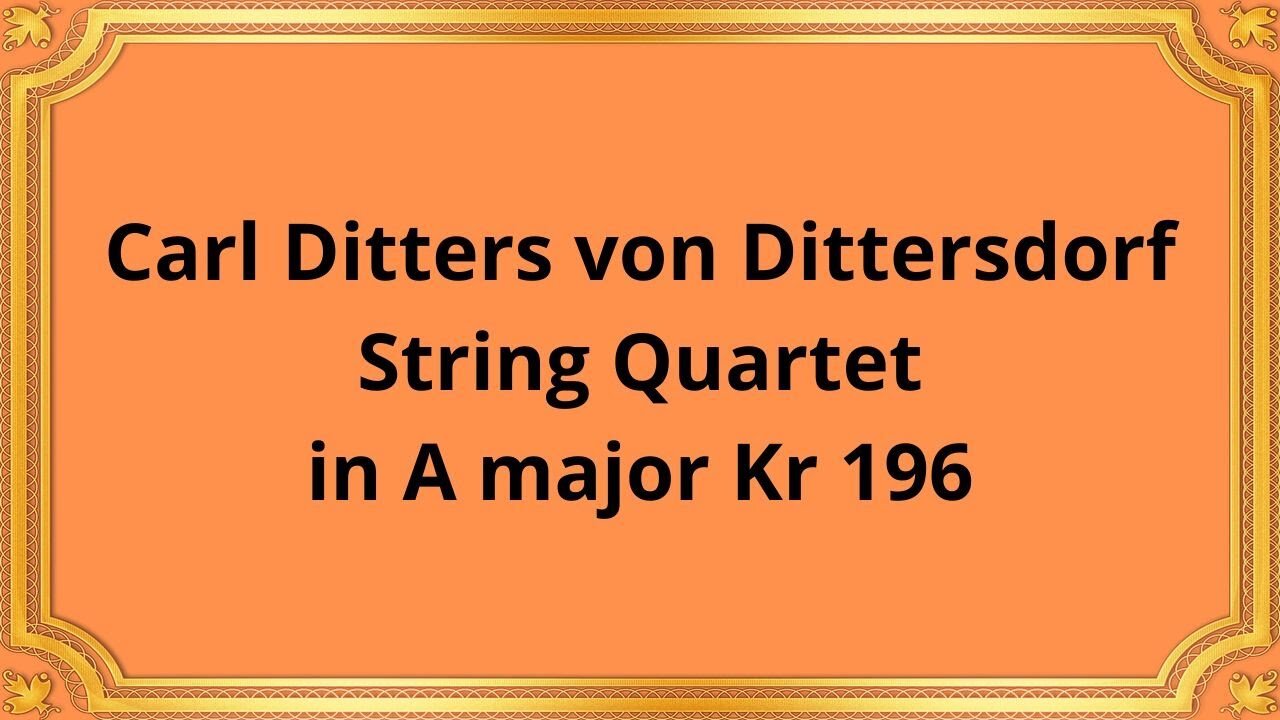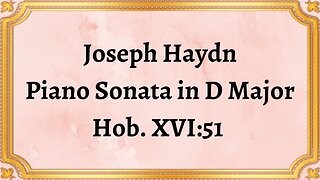Premium Only Content

Carl Ditters von Dittersdorf String Quartet in A major Kr 196
#classicalmusic #CarlDittersvonDittersdorf #StringQuartetinAmajor #Kr196 #chambermusic #stringquartet #classicalcomposers #classicalrepertoire #musichistory #Dittersdorfsquartets #chambermusicrepertoire
Publication date 1937
Perole String Quartet
Joseph Colman (violin I)
Max Hollaender (violin II)
Lillian Fuchs (viola)
Ernst Silberstein (’cello)
Classical music encompasses a vast array of compositions that have captivated audiences for centuries. Among these masterpieces is the String Quartet in A Major, Kr 196, composed by Carl Ditters von Dittersdorf.
Carl Ditters von Dittersdorf, born in 1739, was an Austrian composer and violinist of the Classical era. He was a prolific composer, known for his contributions to various genres, including symphonies, concertos, and chamber music. Dittersdorf's compositions showcased his distinctive style, blending elements of the Classical and Rococo periods.
The String Quartet in A Major, Kr 196, is a chamber music composition by Carl Ditters von Dittersdorf. The exact date of its composition is not known, but it is believed to have been written in the late 18th century. This quartet is written for the standard string quartet ensemble, comprising two violins, viola, and cello.
The String Quartet in A Major, Kr 196, exemplifies Dittersdorf's ability to create engaging and expressive music within the framework of a string quartet. The composition consists of four movements: Allegro, Andantino, Menuetto, and Presto. Each movement offers a distinct musical character and contributes to the overall narrative of the piece.
The opening Allegro presents a lively and energetic melody, showcasing Dittersdorf's skillful handling of the string quartet's interplay and dynamics. The Andantino movement follows, providing a contrasting mood with its lyrical and expressive melodies. The Menuetto, a dance-like movement, injects a sense of elegance and charm into the composition. Finally, the Presto finale brings the quartet to a thrilling and exhilarating conclusion, featuring rapid passages and virtuosic displays.
The String Quartet in A Major, Kr 196, holds significance as a testament to Dittersdorf's contributions to the chamber music repertoire. His compositions, including this quartet, played a vital role in the development of the string quartet genre during the Classical era. Dittersdorf's ability to blend technical proficiency with expressive lyricism is evident in this composition, making it a valuable addition to the classical repertoire.
The enduring legacy of Dittersdorf's String Quartet in A Major, Kr 196, lies in its ability to captivate listeners with its melodic beauty, harmonic richness, and intricate craftsmanship. Performances of this quartet by renowned string quartets around the world continue to highlight Dittersdorf's compositional genius and his significant contribution to the classical music canon.
Conclusion:
Carl Ditters von Dittersdorf's String Quartet in A Major, Kr 196, stands as a testament to the composer's skillful craftsmanship and his impact on the chamber music genre. Through its engaging melodies, expressive harmonies, and dynamic interplay, the quartet showcases Dittersdorf's ability to create captivating music within the string quartet framework. As we explore the depths of this remarkable composition, we gain a deeper appreciation for Dittersdorf's legacy and his lasting influence on the world of classical music.
You have the opportunity to support the channel:
https://destream.net/live/RadSiarAl/donate
https://www.buymeacoffee.com/6355radsiaral
-
 6:07
6:07
Classical music_Music Inspiration
2 days agoJoseph Haydn Piano Sonata in D Major, Hob. XVI:51
301 -
 57:43
57:43
The StoneZONE with Roger Stone
2 hours agoWhat Will The JFK Assassination Files Reveal? | The StoneZONE w/ Roger Stone
11.5K8 -
 18:24
18:24
Tundra Tactical
5 hours ago $0.36 earnedWhats New With HRT Tactical Gear at SHOT Show 2025
27.2K5 -
 23:27
23:27
Rethinking the Dollar
5 hours agoWealth Protection SECRETS Learned from Wildfires w/ Paul Stone
16.8K3 -
 DVR
DVR
Flyover Conservatives
21 hours agoInsider Reacts to Trump’s 100 Hours: Davos, WHO, Climate Change, DEI… - Alex Newman | FOC Show
6.48K -
 1:04:30
1:04:30
Battleground with Sean Parnell
8 hours agoPresident Trump Is Flooding The Zone
93.8K10 -
 LIVE
LIVE
We Like Shooting
14 hours agoWe Like Shooting 595 (Gun Podcast)
151 watching -
 DVR
DVR
megimu32
3 hours agoON THE SUBJECT: 90s Toys, Fat Phobia, and Crying Libs!
9.33K2 -
 LIVE
LIVE
Right Side Broadcasting Network
12 hours agoLIVE REPLAY: President Trump Addresses House GOP in Doral, FL - 1/27/25
4,733 watching -
 2:37:19
2:37:19
Robert Gouveia
6 hours agoTrump Addresses House Republicans; Tulsi Confirmation Fight; CIA Lab Leak
42.6K25